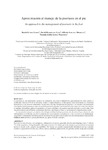Mostrar o rexistro simple do ítem
Aproximación al manejo de la psoriasis en el pie
| dc.contributor.author | López-López, Daniel | |
| dc.contributor.author | Rodríguez Sanz, David | |
| dc.contributor.author | Soriano-Medrano, Alfredo | |
| dc.contributor.author | López Martínez, Noemia Zeltia | |
| dc.date.accessioned | 2022-02-09T10:36:12Z | |
| dc.date.available | 2022-02-09T10:36:12Z | |
| dc.date.issued | 2014 | |
| dc.identifier.citation | López López, D., Rodríguez Sanz, D., Soriano Medrano, A., & López Martínez, N. Z. (2013). Aproximación al manejo de la psoriasis en el pie. Revista Internacional de Ciencias Podológicas, 8(1), 9-24. | es_ES |
| dc.identifier.issn | 1887-7249 | |
| dc.identifier.uri | http://hdl.handle.net/2183/29742 | |
| dc.description.abstract | [Resumen] La psoriasis es una enfermedad cutánea, no contagiosa, de carácter inflamatorio, generalmente de curso crónico y recidivante. Afecta al 3% de la población, siendo el origen idiopático, si bien parece estar relacionada con el sistema inmunitario y con factores ambientales en personas con una susceptibilidad genética. Las lesiones son usualmente distribuidas simétricamente y están característicamente localizadas a nivel general en las orejas, los codos, las rodillas, el ombligo, la hendidura glútea, los genitales y el cuero cabelludo y de manera especial en los pies y en las uñas. Esta afección ocasiona perturbación ocupacional, deterioro psicológico y físico, y una potencial estigmatización social.La carencia de consenso en relación a la etiología multifactorial que presenta esta afección y la prevalencia de esta enfermedad a nivel del pie, nos lleva a mejorar los conocimientos existentes en lo que se refiere a su clasificación, diagnóstico y tratamiento en la búsqueda de actualizar los conceptos relacionados con esta enfermedad no transmisible. | es_ES |
| dc.description.abstract | [Abstract] Psoriasis is a skin disease, not contagious, inflammatory in nature, generally chronic and relapsing course. It affects 3% of the population, being idiopathic, although it seems to be related gives the immune system and environmental factors in people with a genetic susceptibility. The lesions are usually symmetrically distributed and are typically located at a general level in the ears, elbows, knees, umbilicus, gluteal cleft, the genitals and the scalp and especially in the feet and nails. This condition causes disturbance occupational psychological and physical deterioration, and potential social stigmatization.The lack of consensus regarding the multifactorial etiology has this condition and the prevalence of this disease at foot level, leads to improved knowledge in regard to their classification, diagnosis and treatment in the quest to update concepts related to this non communicable disease. | es_ES |
| dc.language.iso | spa | es_ES |
| dc.publisher | UCM | es_ES |
| dc.relation.uri | http://dx.doi.org/10.5209/rev_RICP.2014.v8.n1.43252 | es_ES |
| dc.rights | Atribución 3.0 España | es_ES |
| dc.rights.uri | http://creativecommons.org/licenses/by/3.0/es/ | * |
| dc.subject | Psoriasis | es_ES |
| dc.subject | Placas psoriásicas | es_ES |
| dc.subject | Pie | es_ES |
| dc.subject | Guías clínicas | es_ES |
| dc.subject | Concepto | es_ES |
| dc.subject | Psoriatic plaques | es_ES |
| dc.subject | Foot | es_ES |
| dc.subject | Clinical guidelines | es_ES |
| dc.subject | Concept | es_ES |
| dc.title | Aproximación al manejo de la psoriasis en el pie | es_ES |
| dc.title.alternative | An approach to the management of psoriasis in the foot | es_ES |
| dc.type | info:eu-repo/semantics/article | es_ES |
| dc.rights.access | info:eu-repo/semantics/openAccess | es_ES |
| UDC.journalTitle | Revista Internacional de Ciencias Podológicas | es_ES |
| UDC.volume | 8 | es_ES |
| UDC.issue | 1 | es_ES |
| UDC.startPage | 9 | es_ES |
| UDC.endPage | 24 | es_ES |
Ficheiros no ítem
Este ítem aparece na(s) seguinte(s) colección(s)
-
GI-UDISAP - Artigos [194]






